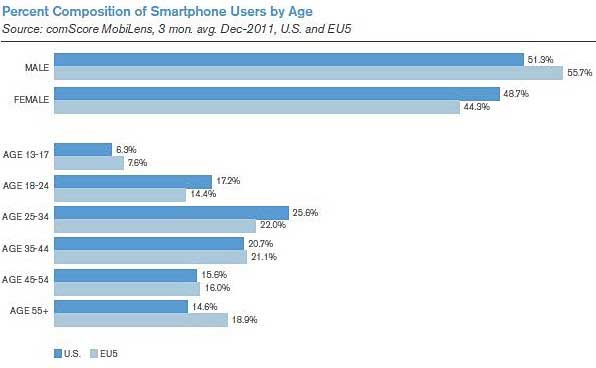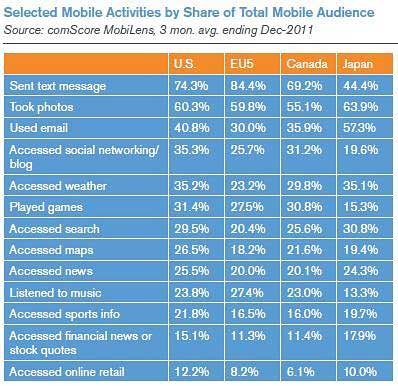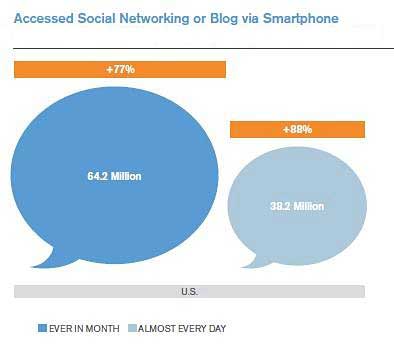The year 2011 was pivotal for the mobile industry, marked by a near doubling in smartphone ownership, consumers' growing appetite for mobile social content, and tablets emerging as a formidable fourth screen, according to a new report by comScore.
Moreover, 2012 is expected to bring more change, as the mobile industry continues to innovate, and as consumers increasingly integrate mobile behaviors into their lives, using multiple devices and platforms, according to the report.
Below, an overview of comScore's annual mobile report, "2012 Mobile Future in Focus," which explores trends in four broad areas: smartphone adoption; mobile media consumption; platform ecosystem dynamics; and tablet adoption and shifts in multi-device digital media consumption.
Smartphone Adoption
Some 48.1% of all US mobile subscribers owned a smartphone as of December 2011, up 21.1 percentage points (PPs) from 27.0% one year earlier.
Smartphone ownership among men (51.3%) is slightly higher than for women (48.3%), while the sweet spot in terms of age is between 25 and 44: 25.6% of mobile subscribers are age 25-34 and 20.7% are age 35-44:

Mobile Content Consumption
In the US, mobile media consumption—defined as browsing the mobile Web, accessing applications, or downloading content—recorded positive growth as of December 2011:
- 47.6% of mobile subscribers used apps, up 13.3 PPs from 34.3% in December 2010.
- 47.5% of mobile subscribers used mobile browsers, up 11.1 PPs from 36.4%.
Across various mobile activities, Americans and Canadians were most likely to access social networking sites or blogs via mobile device, with 35.3% and 31.2% doing so, respectively, as of December.

Americans were also most likely to access maps and news on their phone with one in four engaging in those behaviors at year-end.
Mobile Social Networking Surges
Smartphones played a bigger role in people's daily lives: 64 million smartphone owners in the US accessed social networking or blog destinations via mobile device as of December, up 77% from December-2010 levels. Among those consumers, more than one-half accessed such sites on a daily basis, up 88% year over year.

Smartphones as Shopping Companions
The smartphone became an increasingly useful shopping tool in 2011, though men and women displayed different patterns of shopping behavior:
- Women were more likely to use their smartphone to make shopping a more social experience: 24% took product pictures, 20.2% sent those pictures to friends/family, and 22.3% called or sent text messages to family/friends about a specific product.
- Men were more likely to use their smartphone to find information: 20.4% scanned a product barcode, 14.1% compared prices, and 10.9% researched product features via smartphone.
QR codes were on the scene: One in five US smartphone owners scanned a QR code with their phone as of December, as did 16.1% of Canadians.
The OS Platform Mix
The smartphone market recorded shifts in market share over the past year with Android and iOS devices gaining share at the expense of everyone else.
Among the top three OS platforms:
- Android now ranks as the leading smartphone platform with 47% of market share as of December 2011, up 17 PPs from 29% one year earlier.
- iOS smartphone gains were modest, reaching 30% in market share as of December, up 5 PPs from 25% in December 2010.
- RIM, now the third leading platform in the US, recorded the greatest attrition with its market share halving in the previous year, to 16%.

In addition, the data suggest that many RIM users are shifting to Android when they buy a new smartphone: Among RIM users who purchased a new smartphone in 2011, 31% selected Android phones whereas 43% stayed with a RIM device.
Tablets and Multi-Platform Consumption
Tablets entered the broader mobile marketplace in 2011.
In less than two years after their introduction, nearly 40 million tablets were in use among mobile subscribers in the US, outpacing smartphones, which took seven years to achieve the same level of adoption.
Some 14.3% of US mobile subscribers also owned a tablet as of December, signaling an important trend: connected devices appear to encourage cross-platform media consumption.
An analysis of consumption patterns of newspaper sites show that consumers are likely to turn to different devices for news at various points in a day.
Across three device categories (tablet, mobile, and computer) that drive traffic to newspaper sites, mobile phones and tablets drive less traffic to newspaper sites in the middle of a given weekday (e.g., Tuesday January 2012) relative to the total traffic those devices drive to newspaper sites in a day.

By contrast, computers display higher relative consumption of newspaper traffic in this period, as most people spend most of the time on weekdays interacting with their computers.
The Big Mobile Picture
As of December, mobile and connected devices were driving approximately 8% of observed Internet traffic in the US. Mobile accounted for most of that traffic at 5.2%, while tablets delivered 2.5% of all digital traffic in the market.
In the US alone, there were more than 400 smartphone devices on the market by the end of 2011.
Moreover, in July, smartphones surpassed feature phones to account for most new device purchases for the first time during 2011.
About the data: Findings are from comScore's annual mobile report, "2012 Mobile Future in Focus," based on data provided by comScore MobilLens and comScore Custom Analytics, for the three-month period ended December 2011, unless otherwise noted.



